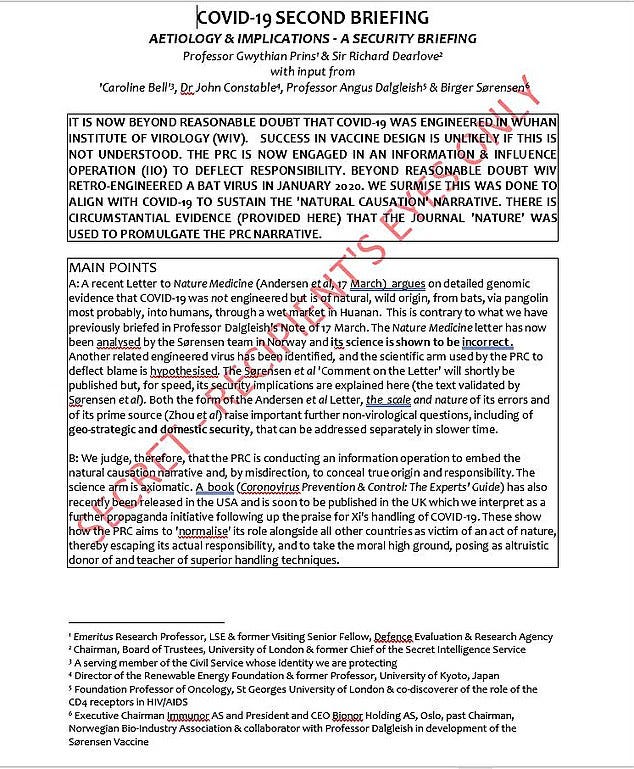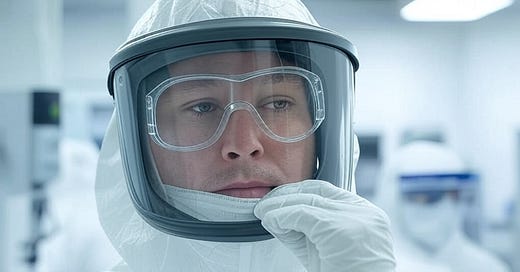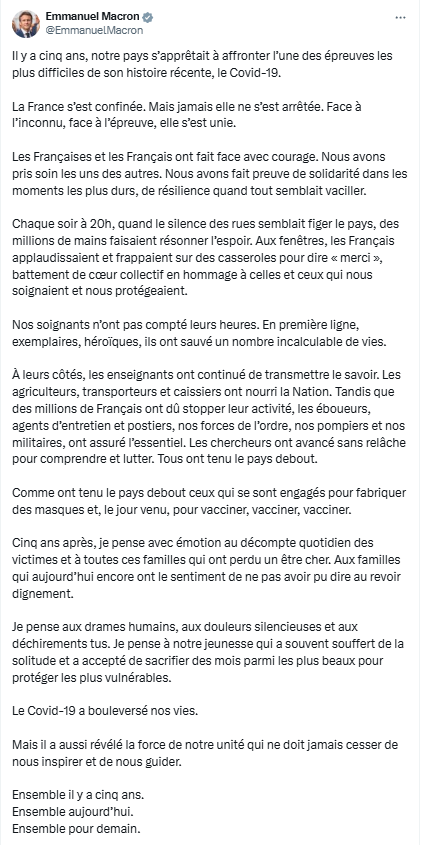[ Analysis ] The Origins of Covid: True Lies
A series of clues points to the laboratory creation of the Covid virus. Did France, which built the Wuhan P4 lab alongside Chinese companies, have knowledge of this?

Michael Shellenberger, whom we interviewed on March 10th, has just released a British memo classified as “secret, recipient’s eyes only.” This document is a briefing from early 2020 intended for Boris Johnson, then Prime Minister. Among its authors is Sir Richard Dearlove, a former head of MI6, the British foreign intelligence service.
It thus appears that the highest levels of the British government were aware that the Covid virus, SARS-CoV-2, was possibly man-made and that the outbreak might stem from a leak at the BSL 4 (Biosafety Level 4) laboratory of the Wuhan Institute of Virology in China. This implies that everyone—from Washington to Paris, Berlin, Rome, Madrid, and beyond—was also in the know. And it seems that ever since, they have all likely lied about the pandemic’s origins. Questioning the possible laboratory creation of the virus was dismissed as a conspiracy theory. It was the pangolin, end of story.
This sheds light on the palpable anxiety of Emmanuel Macron, who posted a grandiose tweet marking the fifth anniversary of the absurd and ineffective lockdown that devastated our economy and the mental health of many French —children foremost among them.
The confirmation of Robert F. Kennedy Jr.—still a target of defamatory press campaigns in Europe—as head of the U.S. Department of Health and Human Services, alongside Dr. Jay Bhattacharya, a vocal critic of lockdowns, Covid crisis management, and blanket vaccination policies, as director of the National Institutes of Health (NIH) is likely fueling this widespread panic.
In France, there’s an effort to sweep the mess under the rug. The narrative being pushed is that anything coming out of the United States now, post-Donald Trump’s election, is “anti-science.” The latest twist in this attempt to manipulate public opinion? Beyond the conveniently timed book by Messrs. Davet and Lhomme—which limits its investigation to the French Court of Justice of the Republic’s case file, sidestepping the virus’s origins and the now-proven inefficacy of mRNA vaccines—former Health Minister Agnès Buzyn has launched a think tank called “Evidences” with much fanfare. Brace yourself: to put science back at the heart of society, Buzyn declares, “We need a policy to combat disinformation.”
Such a pressing threat seemed to necessitate what was described as a “whole of society” approach, meaning the totalizing integration of government, military, private sector, and non-profit spheres, as well as international organizations, in service of defending “democracy.” This united front of public and private organizational power is the real “deep state”, N.S. Lyons noted in an essay L’Eclaireur translated to French.
One should always be wary of intelligence agencies, especially the British ones—arguably the most cunning on the planet. Yet the mounting evidence makes it hard to deny the likely origin of the Covid virus, which appears to have been engineered in a lab, and the pandemic, probably triggered by a leak from the BSL 4 lab at the Wuhan Institute of Virology.
As always, the story is a bit more complex, and pinning it all on China is too convenient. The Wuhan Institute’s BSL 4 lab was the result of an international collaboration, driven by the fact that SARS-type viruses consistently originate in that region of the world.
In 2014, the United States imposed a moratorium halting funding for gain-of-function research. “Gain-of-function research on viruses like influenza, MERS (Middle East Respiratory Syndrome coronavirus), and SARS (Severe Acute Respiratory Syndrome) could help us identify, understand, and develop strategies and effective countermeasures against rapidly evolving pathogens that pose a threat to public healt”,’ stated Francis S. Collins, then-director of the NIH, to justify lifting the moratorium in 2017.
It is now confirmed that the United States funded gain-of-function research at the Wuhan Institute of Virology. Fuding was suspended in 2023, officially due to breaches in safety protocols.
Let’s not overlook the laboratories in Ukraine, whose existence was acknowledged under oath by Victoria Nuland, then the number three in U.S. diplomacy, during a March 2022 Senate hearing when grilled by Marco Rubio, now Secretary of State. The nature of the research conducted there remains unknown to this day.
To oversimplify, a BSL4 laboratory is like a box in a box in a box in a box. Each box’s atmosphere is sealed off from the others and regenerated in a closed loop. These boxes are isolated from one another by cutting-edge technologies, often classified. Moving between them requires passing through decontamination airlocks and wearing protective gear, including Hazmat suits and self-contained breathing apparatuses—except in the innermost box, where the most virulent pathogens are stored. No one can enter that final layer. While new strains can be added to this pathogen library, they’re not supposed to leave. In case of an incident, each box has a decontamination system; in the last one, housing the deadliest strains, it can be resorted to ultra-high-temperature incineration to ensure total destruction of the pathogen library.
If the Covid pandemic indeed originated from a leak at the BSL 4 lab at the Wuhan Institute of Virology, only two scenarios are plausible.
First, a massive breach of biosafety protocols, implying that one or more employees managed to smuggle a virus out of the lab. Believe it or not, this has happened before: in 2015, a virologist with the Pasteur Institute in South Korea illegally transported three MERS coronavirus samples from Seoul to Paris in a cosmetics box in her carry-on luggage. Worse still, those samples sat on a researcher’s office shelf at the Pasteur Institute for a week without any safety precautions.
The second possibility is a failure in the lab’s containment or decontamination systems.
As noted earlier, the Wuhan Institute’s BSL 4 lab was an international effort. France, working with Chinese companies, built the facility and supplied its containment technologies—derived from systems originally developed for military nuclear purposes.
Multiple independent and corroborating sources suggest that the Wuhan BSL 4 lab was in part modeled on the BSL 4 facility operated by France’s Directorate General of Armament in Vert-le-Petit, Essonne, inaugurated in 2013 by then-Defense Minister Jean-Yves Le Drian, as well as on the older BSL4 lab of the Mérieux foundation located in the Lyon area.
The cooperation agreement for the Wuhan BSL 4 lab was signed in 2004 by Michel Barnier, France’s foreign minister. At the same time, France was negotiating with China the construction of five EPR nuclear power plants. China ultimately built only two in its southern region before abandoning the program in favor of its own reactors.
That’s the official story. There’s also an unofficial version involving the 2009 “disappearance” of Kang Rixin, head of China’s civilian nuclear program, followed by his reappearance in 2010 to face a life sentence for corruption. This coincided with the unraveling of the massive UraMin scandal—you know, the Canadian “junior” mining company hastily bought by Areva for €1.8 billion between the two rounds of the 2007 French presidential election, despite its five concessions being well-known to geologists for decades and deemed unprofitable by their discoverers (including France’s Atomic Energy Commission). Looming the background, a nasty state affair.
Beyond official trade-offs, bribes and kickbacks are, unfortunately, par for the course in such state-to-state megadeals, often facilitated by intermediaries. On December 2, 2024, Areva—now Orano—paid a €4.8 million fine as part of a plead deal with France’s National Financial Prosecutor’s Office to settle corruption charges involving Mongolian public officials.
The construction of the Wuhan BSL 4 lab faced numerous hurdles. French military officials opposed it, fearing China could use it to develop biological weapons. There was also Beijing’s refusal to disclose what it had done with the mobile P3 labs funded by the French government after the 2003 SARS outbreak—hardly a confidence booster for cooperation.
Completed in 2015, the lab’s construction was overseen by the French engineering firm Technip, a national champion acquired in 2016 by Texas-based FMC Technologies with the tacit approval of then-Economy Minister Emmanuel Macron. Technip refused to certify the lab, but certification was nonetheless granted in 2017, celebrated at a ceremony attended by then-Prime Minister Bernard Cazeneuve, Health and Social Affairs Minister Marisol Touraine, and Yves Lévy, president of INSERM (the French counterpart of the NIH) and husband of Agnès Buzyn. It was announced that 50 French researchers would take up residence at the lab—researchers who, to our knowledge, were still there in 2020.
In January 2018, U.S. embassy staff visited the lab and, according to The Washington Post, raised concerns about inadequate safety measures where bat-borne coronaviruses were being studied. Given that the WaPo often serves as a CIA mouthpiece, one wonders if these warnings were also part of an operation to discredit the lab and edge out the French, who had permanent access.
In 2020, at the height of the pandemic, Donald Trump began loudly blaming a “Chinese virus” and a lab leak. Persistent rumors questioning the French-supplied containment technologies at Wuhan circulated, causing such a stir in Paris that, per our sources, one of the capital’s most powerful fixers, Anne Méaux of Image 7 and former press attaché of President Valéry Giscard d’Estaing, was enlisted to kill the story in the media.
Blaming China alone is decidedly too easy, though its responsibility can’t be dismissed—especially if it’s proven to have covered up a lab leak. But let’s not forget that Western nations outsourced research deemed too controversial, dangerous or unethical for their own soil to the Wuhan Institute. In the U.S., the full story will eventually come out. In Europe and France, that’s less likely. The whole Covid crisis magament has been classified. Roselyne Bachelot, health minister during the overhyped 2009 H1N1 outbreak (which saw a questionable vaccine-buying spree akin to Covid) and Macron’s former minister of culture, has been appointed head of the Commission on the History of Health Insitutions—convenient for purging the archives and rewriting the narrative.





![[ Ukraine ] Ces labos de recherche "bactériologique" dont les USA ont nié l'existence pendant deux semaines](https://substackcdn.com/image/fetch/w_140,h_140,c_fill,f_auto,q_auto:good,fl_progressive:steep,g_auto/https%3A%2F%2Fbucketeer-e05bbc84-baa3-437e-9518-adb32be77984.s3.amazonaws.com%2Fpublic%2Fimages%2F4ace3769-19c6-4561-a27b-024fec6e6f3d_976x549.jpeg)